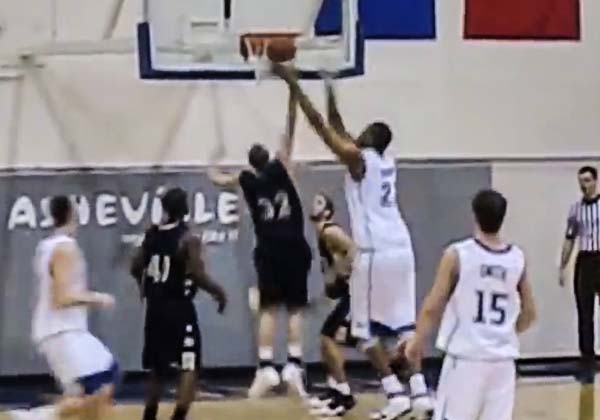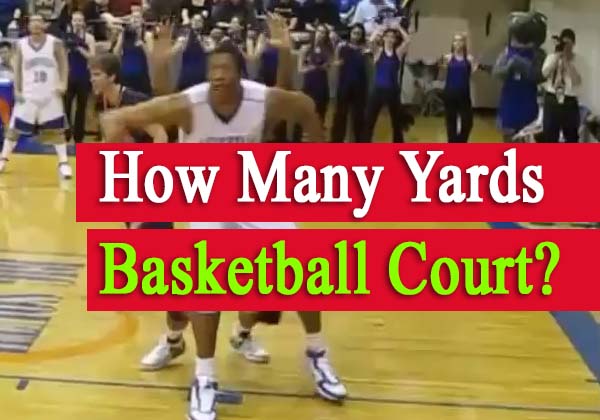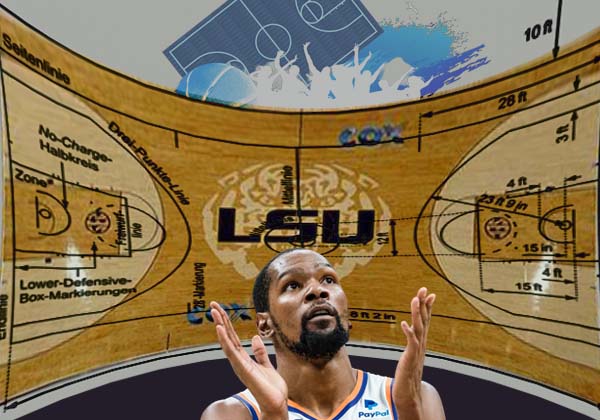If you are a fan of Basketball then this question must have come in your mind that How Many Yards Is a Basketball Court?, the game is played on a rectangular Court with Baskets at each end. But do you know how many yards is a Basketball Court? And how does it vary depending on the level of competition and the location of the Court?
We will also give you some interesting facts and history about the Basketball Court and its dimensions. Knowing the Court size can help you appreciate the game better and improve your skills, whether you are a player, a coach, or a spectator.
Basketball Court Standard Dimensions
The length and width of a Basketball Court depend on the level of competition and the governing body of the sport. For example, in the National Basketball Association NBA, the Court is 94 feet by 50 feet (28.7 by 15.2 meters). Under International Basketball Federation FIBA rules, the Court is slightly smaller, measuring 28 by 15 meters (91.9 by 49.2 feet).
In amateur Basketball, Court sizes vary widely. Many older high school gyms were 84 feet (26 meters) or even 74 feet (23 meters) in length. The baskets are always 10 feet (3.05 meters) above the floor (except possibly in youth competition).
Basketball Courts have a three-point arc at both baskets. A basket made from behind this arc is worth three points; a basket made from within this line or with a player’s foot touching the bar is worth two points. The free-throw line, where one stands while taking a foul shot, is located within the three-point arc at 15 feet (4.57 meters) from the plane of the backboard. A bad shot is worth one point, but if an attempt is made from the foul line while in play, it is still worth two points.
Basketball Court Dimensions for different levels of competition:

How to Calculate the Basketball Court in Yards
To convert the dimensions of a Basketball Court in feet to yards, we simply divide each measurement by three since one yard equals three feet.
For example, an NBA Basketball Court is 94 feet by 50 feet in size. To get the equivalent in yards, we divide each number by three:
94 / 3 = 31.33 yards 50 / 3 = 16.67 yards
Therefore, an NBA Basketball Court is approximately 31.33 yards by 16.67 yards in size.
Similarly, we can convert the dimensions of other Basketball Courts into yards by dividing each measurement by three.
For example, a FIBA Basketball Court is 28 meters by 15 meters tall. To get the equivalent in yards, we first need to convert each measurement to feet since one meter equals about 3.28 feet.
28 x 3.28 = 91.84 feet 15 x 3.28 = 49.2 feet
Then, we divide each number by three:
91.84 / 3 = 30.61 yards 49.2 / 3 = 16.4 yards
Therefore, a FIBA Basketball Court is approximately 30.61 yards by 16.4 yards in size.
Basketball Court: Dimensions – History
The game of Basketball was invented by James Naismith in Springfield, Massachusetts, in December of 1891 as an indoor activity for his students during winter.

The first Basketball Court was a gymnasium floor with peach baskets nailed to opposite walls as goals. Naismith did not specify the original dimensions of the Court, but they were roughly Half the size of today’s NBA Courts.
The first official Basketball rules were published in January of 1892, and they stated that “the Court may be of any size that suits the convenience of the players.” However, they also suggested that “a space of 50 feet by 35 feet is desirable”.
As the game became more popular and spread to different places, the size and shape of the Court also changed to accommodate various venues and preferences. For example, some Courts were made longer or wider, some had balconies or pillars that interfered with play, and some had irregular shapes such as circles or ovals.
The first standardized Basketball Court dimensions were adopted by the NCAA in 1932. They set the Court length at 90 feet and the width at 50 feet, which is still used today in College Basketball.
The NBA, founded in 1946, initially used the exact Court dimensions as the NCAA but later changed them to 94 feet by 50 feet in 1949 to create more space for players and spectators.
The FIBA, founded in 1932 as the international governing body of Basketball, also adopted the exact Court dimensions as the NCAA until 1956, when they changed them to 28 meters by 15 meters to conform to the metric system.
The three-point line, a semicircular arc extending from both sides of the Court to a certain distance from the Basket, was introduced at different times and places to encourage more shooting and scoring.
The American Basketball League (ABL) used the first three-point line in 1961. It was set at 25 feet from the Basket, except for the corners, where it was 22 feet.
The NBA adopted the three-point line in 1979. It was initially set at 22 feet from the Basket all around but later changed to 23.75 feet in most areas and 22 feet in the corners in 1994.
The NCAA adopted the three-point line in 1986. It was initially set at 19.75 feet from the Basket all around but later changed to 20.75 feet in most areas and 21.65 feet in the corners in 2008 for men’s play and in 2011 for women’s play.
The FIBA adopted the three-point line in 1984. It was initially set at 20.5 feet from the Basket all around but later changed to 22.15 feet in most areas and 21.65 feet in the corners in 2010.
How Many Yards Is a Basketball Court?
We hope you enjoyed this article and learned something new about Basketball Courts and their dimensions.
- The size of a Basketball Court depends on the competition level and the sport’s governing body.
- The standard Basketball Court dimensions for NBA, FIBA, NCAA, and high school are different in terms of length, width, three-point line distance, and critical width.
- To calculate the Basketball Court dimensions in yards, we divide each measurement in feet by three or convert each size in meters to feet and then divide by three.
- The Basketball Court has evolved from a gymnasium floor with peach baskets to a rectangular surface with standardized measurements and features.
- The three-point line was introduced at different times and places to encourage more shooting and scoring.
If you want to learn more about Basketball and improve your skills, check out our website, sports-news-it.site, where you can find the latest and most accurate news.

Court Length
The Court length is the same for NBA and NCAA at 94 feet (31.33 yards), while it is slightly shorter for FIBA at 28 meters (30.61 yards) and much faster for high school at 84 feet (28 yards).
The Court length affects the pace and style of play in different ways. A longer Court means more space for players to run, pass, and shoot, leading to a faster and more exciting game. However, it also means more fatigue and turnovers, especially if the players need to be better-conditioned or disciplined.
A shorter Court means less space for players to operate, leading to a slower and more physical game. However, it also means less distance to cover on defense and offense, making the game more accessible and more efficient.
Court Width
The Court width is the same for all levels of competition at 50 feet (16.67 yards), except for FIBA, which has a slightly narrower Court at 15 meters (16.4 yards).
The Court width affects the spacing and angles of play in different ways. A wider Court means more room for players to spread out, cut, and drive, creating more scoring opportunities and better ball movement. However, it also means more ground to cover on defense and more difficulty trapping or double-teaming.
A narrower Court means less room for players to maneuver, which can limit their options and creativity on offense. However, it also means less space for defenders to help or rotate, which can make it easier to exploit mismatches or isolate one-on-one.
Three-Point Line Distance
The three-point line distance is different for each level of competition, with NBA having the longest distance at 23.75 feet (7.92 yards) in most areas and 22 feet (7.33 yards) in the corners, FIBA having the second longest distance at 6.75 meters (7.38 yards) in most areas and 6.6 meters (7.22 yards) in the corners, NCAA having the third longest distance at 20.75 feet (6.92 yards) in most areas and 21.65 feet (7.22 yards) in the corners, and high school having the shortest distance at 19.75 feet (6.58 yards) all around.
The three-point line distance affects the shooting and scoring of play in different ways. A longer distance means more difficulty and risk in making three-point shots, which can lower the shooting percentage and efficiency of teams and players. However, it also means more reward and value in making three-point shots, which can increase the scoring potential and spacing of teams and players.
A shorter distance means less difficulty and risk in making three-point shots, which can raise the shooting percentage and efficiency of teams and players. However, it also means less reward and value in making three-point shots, which can decrease the scoring potential and spacing of teams and players.
Key Width
The key width is different for each level of competition, with NBA having the widest key at 16 feet (5.33 yards), FIBA having the second most comprehensive key at 4.9 meters (5.36 yards), and NCAA and high school having the narrowest key at 12 feet (4 yards).
The critical width affects the post and perimeter play in different ways. A wider key means more space for post players to operate, which can create more scoring opportunities and better passing lanes. However, it also means more distance for perimeter players to help or recover, making it harder to defend the paint or contest shots.
A narrower key means less space for post players to operate, which can limit their scoring opportunities and passing lanes. However, it also means less distance for perimeter players to help or recover, which can make it easier to defend the paint or contest shots.
How to Use the Court Size to Your Advantage
Knowing the size of the Court can help you improve your game and strategy as a player or a coach. Here are some tips and tricks on how to use the Court size to your advantage:
- If you are playing on a long Court, you can use your speed and stamina to outrun your opponents and create fast break opportunities. You can also use your passing and shooting skills to stretch the defense and exploit the open spaces. However, it would be best if you also were careful not to overdo it, conserve energy, and avoid turnovers.
- If you are playing on a shorter Court, you can use your strength and physicality to outmuscle your opponents and create Half-Court opportunities. You can also use your dribbling and driving skills to penetrate the defense and draw fouls. However, it would be best if you also were careful not to force it, move the ball, and find the best shot.
- If you are playing on a wider Court, you can use your spacing and movement to create mismatches and confusion for the defense. You can also use your cutting and screening skills to get open and receive passes. However, it would be best if you also were careful not to settle for outside shots and attack the basket when possible.
- If you are playing on a narrower Court, you can use your defense and teamwork to create pressure and disruption for the offense. You can also use your trapping and double-teaming skills to force turnovers and get steals. However, it would be best if you also were careful not to foul or give up easy baskets.
- If you are playing on a Court with a longer three-point line distance, you can use your shooting range and confidence to make three-point shots and increase your scoring potential. You can also use your pump fake and step-back skills to create space and get better shots. However, it would be best if you were careful not to rely too much on three-point shots and balance your offense with other options.
- If you are playing on a Court with a shorter three-point line distance, you can use your shooting accuracy and consistency to make three-point shots and increase your shooting efficiency. You can also use your drive-and-kick and pick-and-roll skills to create opportunities for yourself or your teammates. However, it would be best if you also were careful not to ignore other aspects of the game, such as defense, rebounding, and passing.
- If you play on a Court with a broader key, you can use your post skills and footwork to dominate the paint and score inside. You can also use your passing vision and awareness to find open teammates or cutters. However, you should also be careful not to get trapped or double-teamed in the post and keep the ball moving.
- If you are playing on a Court with a narrower key, you can use your post defense and positioning to protect the paint and prevent easy baskets. You can also use your help defense and rotation skills to cover for your teammates or contest shots. However, it would be best if you also were careful not to give up too much space or fouls in the post and stay disciplined.
Frequently Asked Questions:
Here are some common questions that people have about Basketball Courts and their dimensions:
How many yards is a Half-Court Basketball Court?
A: A Half-Court Basketball Court is Half the length of a full-Court Basketball Court but the same width. Therefore, to calculate the dimensions of a Half-Court Basketball Court in yards, we divide the size of a full-Court Basketball Court by two and keep the width the same.
For example, an NBA Half-Court Basketball Court is 94 feet by 50 feet in size. To get the equivalent in yards, we divide each number by three:
94 / 3 = 31.33 yards 50 / 3 = 16.67 yards
Then, we divide the length by two:
31.33 / 2 = 15.67 yards
Therefore, an NBA Half-Court Basketball Court is approximately 15.67 yards by 16.67 yards in size.
Similarly, we can calculate the dimensions of other Half-Court Basketball Courts in yards by dividing the length of a full-Court Basketball Court by two and keeping the width the same.
For example, a FIBA Half-Court Basketball Court is 28 meters by 15 meters in size. To get the equivalent in yards, we first need to convert each measurement to feet since one meter equals about 3.28 feet.
28 x 3.28 = 91.84 feet 15 x 3.28 = 49.2 feet
Then, we divide each number by three:
91.84 / 3 = 30.61 yards 49.2 / 3 = 16.4 yards
Then, we divide the length by two:
30.61 / 2 = 15.31 yards
Therefore, a FIBA Half-Court Basketball Court is approximately 15.31 yards by 16.4 yards in size.
Q: How many square yards is a Basketball Court?
A: To calculate the area of a Basketball Court in square yards, we multiply the length and width of the Court in yards.
For example, an NBA Basketball Court is approximately 31.33 yards by 16.67 yards in size. To get the area in square yards, we multiply these numbers:
31.33 x 16.67 = 522.5 square yards
Therefore, an NBA Basketball Court is approximately 522.5 square yards in area.
Similarly, we can calculate the area of other Basketball Courts in square yards by multiplying the length and width of the Court in yards.
For example, a FIBA Basketball Court is approximately 30.61 yards by 16.4 yards in size. To get the area in square yards, we multiply these numbers:
30.61 x 16.4 = 501.6 square yards
Therefore, a FIBA Basketball Court is approximately 501.6 square yards in area.
Q: How many meters is a yard?
A: One yard is equal to about 0.9144 meters or 91.44 centimeters.
To convert a measurement from yards to meters, we multiply it by 0.9144.
For example, to convert 10 yards to meters, we multiply it by 0.9144:
10 x 0.9144 = 9.144 meters
To convert a measurement from meters to yards, we divide it by 0.9144.
For example, to convert 10 meters to yards, we divide it by 0.9144:
10 / 0.9144 = 10.94 yards
Conclusion
We hope you enjoyed this article and learned something new about Basketball Courts and their dimensions.
To recap, here are some key points:
- The size of a Basketball Court depends on the competition level and the sport’s governing body.
- The standard Basketball Court dimensions for NBA, FIBA, NCAA, and high school differ in length, width, three-point line distance, and critical width.
- To calculate the Basketball Court dimensions in yards, we divide each measurement in feet by three or convert each size in meters to feet and then divide by three.
- The Basketball Court has evolved from a gymnasium floor with peach baskets to a rectangular surface with standardized measurements and features.
- The three-point line was introduced at different times and places as a way to encourage more shooting and scoring.
- Knowing the size of the Court can help you improve your game and strategy as a player or a coach.
- People have some common questions about Basketball Courts and their dimensions, such as how many yards is a Half-Court Basketball Court, how many square yards is a Basketball Court, and how many meters is a yard.
- There are some valuable resources and references that you can check out to learn more about Basketball Courts and their dimensions.
If you want to learn more about Basketball and improve your skills, check out our website, sports-news-it. site, where you can find the latest and most accurate news for any sports organization of these brands. You can also browse our collections of Basketball shoes, jerseys, hoops, accessories, and more.








3 thoughts on “How Many Yards Is a Basketball Court? An In-Depth Look – Comprehensive Guide”